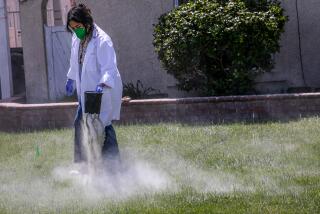Scientists Develop a Coat of Armor for Monuments
- Share via
ALBUQUERQUE, N.M. — The Sphinx, the Parthenon, the Lincoln Memorial--grand monuments of limestone or marble that were designed to immortalize--turn all-too-mortal in the face of the tiniest assailants.
Marble statues and limestone structures, including many of Europe’s finest buildings from the Middle Ages, are being eaten away, molecule by molecule. Acid rain from coal- or oil-fired engines and manufacturing plants have caused much of the damage.
Over the years, preservationists have tried to ward off the harm with various remedies, many of which break down in sunlight or water.
Now, the Sandia National Laboratories scientists hope they have the answer, which also will help prolong the life of concrete used to entomb atomic waste, in a concoction they brewed during three years of research.
Their remedy--chemically similar to glass--is made of a customized two-sided molecule. The organic side attaches itself to carbonate-based stone, limestone or marble; its inorganic side bonds to an inorganic protective layer with a silicon-based polymer.
“We want to [protect] the limestone surface to prevent further acid rain attack, plus we’re trying to strengthen the exterior surface of the stone to prevent it from just crumbling--and also to affect its durability--from freezing and thawing of ice,” says Jeffrey Brinker, a chemist and materials scientist at the nuclear weapons lab.
William S. Ginell, a senior scientist at the Getty Conservation Institute in Los Angeles, said the Sandia scientists are on the right track.
“The first step is to learn what is the interaction between the treatment material that will penetrate into the pores of the stone to strengthen it or prevent it from being attacked by pollutants,” he says.
Water--along with unsightly bird droppings--is a worry at the limestone and marble Lincoln Memorial, completed in 1920 in Washington.
“The problems with the Lincoln Memorial--and the Jefferson Memorial--are not caused nearly as much by pollution as their age and location,” says Earle Kittleman, National Park Service spokesman for the capital area.
“Both are next to the Potomac River. It’s the moisture, the cycle from winter to summer, the temperature changes,” he says.
Brinker, along with George Segan Wheeler, a research chemist at the Metropolitan Museum of Art in New York whose main area of research is developing treatments for cleaning or preserving stone, hatched the preservation idea around 1990 when they met at a conference.
“Any major monument in an urban area made of marble or limestone is going to have a problem,” Wheeler says. “Much of the Western world is carved in these materials [marble or limestone].”
Pollution has scarred Greece’s marble Parthenon, dedicated to the goddess Athena and completed in 438 B.C.
England’s Wells Cathedral, built of limestone between 1180 and 1424, has suffered from acid rain. Other English cathedrals damaged by pollution include York Minster, Salisbury Cathedral and Lincoln Cathedral.
Acid rain also is melting away marble memorials at Gettysburg National Military Park, Pa., where Confederate and Union forces fought in 1863.
Limestone and marble not only suffer the airborne onslaughts of sulfuric and nitric acid in rain, but also the assaults of salts and gypsum. Limestone and marble must breathe, so protective coatings should not prevent liquids from moving in and out of the stone.
“Archeological material taken out of the ground, where they have been for centuries, acquire salts from the soil,” Wheeler says. “They start drying, crystallize and crack the stone.”
The limestone Sphinx, built on Egypt’s Giza plateau 4,600 years ago, was buried by sand for centuries until it was uncovered in 1926. It had been a victim of harmful salts until restoration work drew out the salts and stopped the Sphinx’s flaking.
Wheeler says that when acid rain dissolves limestone or marble, gypsum forms in solution, which can seep into minute cracks in limestone or marble, crystallize and spread the cracks.
Water also can rise through the stone from the ground.
“If water rises in the stone, and if a sealant prevents evaporation, pressures are exerted which will blow off the surface of the stone,” Ginell says.
The Sandia researchers tried their recipe--which forms a coating within the stone’s pores--on powdered calcite, a basic component of limestone, and on limestone core samples that are sensitive to acids.
Kathryn Nagy, who with fellow Sandia geochemist Randall Cygan is conducting the research, says they want to refine their formula, including testing its effects on biological growths.
Researchers are about a year away from trying it on a true, weathered surface instead of the clean, pure minerals they have been working with.
The best coating tested so far will slow one year’s worth of wear to 10 years. “We feel we can improve that by another factor of 10, so that would be 100 years,” Nagy says.
Cygan says the coating is clear and “doesn’t change with time as an organic resin or epoxy would, so it could be used in exterior sculptures or building facades and still preserve the artistic part of the sculpture.”
Nagy says it probably will be several years before the coating is ready for use, but that depends on funding, which stops Sept. 30--the end of Sandia’s fiscal year.
Brinker says museums such as the Metropolitan Museum of Art typically do not have the money, equipment or expertise to conduct the type of research Sandia does.
And when charitable foundations donate money, “they want to buy something new instead of restoring something old,” he says.






